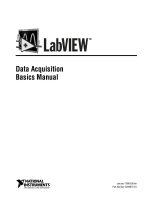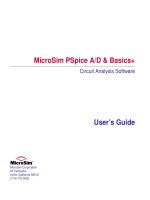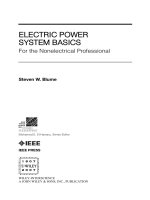Interbus Basics
Bạn đang xem bản rút gọn của tài liệu. Xem và tải ngay bản đầy đủ của tài liệu tại đây (1.16 MB, 20 trang )
INTERBUS
BASICS
IB_Basics_RZ_4C.qxd 26.04.2001 12:50 Uhr Seite 3
IB_Basics_RZ_4C.qxd 26.04.2001 12:50 Uhr Seite 4
2
The INTERBUS fieldbus system is continuously
growing in both the range of applications and in the
number and different types of compatible products
offered. Due to international standardization,
INTERBUS is now a worldwide standard. As a result,
we are often asked to provide information about
INTERBUS basics and INTERBUS-compatible devices.
This guide provides an insight into the system and
its method of operation, as well as a detailed overview
of the components. It also provides an overview of the
connection of products. As a user or manufacturer who
is interested in technology, this guide provides you
with the basics to make working with INTERBUS
easier. If you have any other questions, please contact
your local INTERBUS Club representative, or try our
website.
www.interbusclub.com
INTERBUS CLUB USA
INTERBUS CLUB Brasil
INTERBUS representative South Africa
INTERBUS CLUB New Zealand Inc.
INTERBUS CLUB Japan
INTERBUS CLUB Spain
INTERBUS CLUB France
IB_Basics_RZ_4C.qxd 26.04.2001 12:50 Uhr Seite 5
3
INTERBUS CLUB United Kingdom
INTERBUS CLUB Finland
INTERBUS CLUB Sweden
INTERBUS CLUB Denmark
INTERBUS CLUB International
INTERBUS CLUB Benelux
(Luxembourg)
INTERBUS CLUB Benelux
(Belgium)
INTERBUS CLUB Benelux
(The Netherlands)
INTERBUS CLUB Austria
INTERBUS CLUB Switzerland
INTERBUS CLUB Italy
Contents
Why Fieldbus Technology? Page 4
Selecting a Fieldbus System Page 5
Introduction to INTERBUS Page 7
Basic Elements of INTERBUS Page 8
Data Transmission With INTERBUS Page 9
Automation With INTERBUS Page 11
Operation and Maintenance Page 12
Automation Components in Detail Page 13
Field Components – The Best of Everything Page 14
All Control Systems, One Bus – INTERBUS Page 15
Standardization and Security Page 16
INTERBUS Club – A Strong Community Page 18
PC
Ethernet
I/O
Controller
HMI
I/O
robotics
Loop
IB_Basics_RZ_4C.qxd 26.04.2001 12:50 Uhr Seite 6
4
Why Fieldbus Technology?
The increased competition and
pressure on prices that affects all
areas of production and process
engineering means that all
opportunities for rationalization
must be exploited in full. One
practice that has proved effective
is the automation of
processes using fieldbuses with
the simultaneous reduction
system startup time, and the time
required to adapt the system
based on changing needs. Serial
fieldbus technology
offers numerous advantages
compared with both parallel
wiring, and vendor proprietary
networks.
The growing degree of automation in
machines and systems also increases
the amount of cable required for parallel
wiring due to the large number of I/O
points. This brings with it increased
effort for configuration, installation,
startup, and maintenance. The cable
requirements are often high because, for
example, special cables are required for
the transmission of analog values.
Parallel field wiring thus entails
serious cost and time factors. In
comparison, the serial networking of
components in the field using fieldbus
systems is much more cost-effective.
The fieldbus replaces the
bundle of parallel cables with
a single bus cable and
connects all levels, from the
field to the control level.
Regardless of the type of
automation device used,
e.g., programmable logic
controllers (PLCs) from
various manufacturers or PC-
based control systems, the
fieldbus transmission medium networks
all components. They can be distributed
anywhere in the field and are all
connected locally. This provides a
powerful communication network for
today’s rationalization concepts.
There are numerous advantages to a
fieldbus system in comparison to parallel
wiring: The reduced amount of cabling
saves time during planning and
installation, while the cabling, terminal
blocks, and the control cabinet
dimensions are also reduced. Self-
diagnostics, which are carried out by the
system using plain text displays,
minimize downtimes and maintenance
times. Improved reliability and increased
availability due to short signal paths play
an important role, especially for critical
signals. There is even
greater protection from
faults for analog values.
Open fieldbus systems
standardize data
transmission and device
connection regardless of
the manufacturer. The user
is therefore independent of
any manufacturer-specific
standards. The system can
be easily extended or modified, offering
flexibility as well as investment
protection.
[Figure 1]
A single slim cable replaces heavy cable trees – one cable for all signal types, field devices, PLCs, and PCs
INTERBUS
IB_Basics_RZ_4C.qxd 26.04.2001 12:51 Uhr Seite 7
5
Selecting a Fieldbus System
Many criteria must be considered
when selecting a fieldbus system.
Various requirements must be
met when optimizing the bus
system for the specific task.
These include multi-vendor
support, electrical noise
immunity, and determinism.
Short and constant cycle times, a
highly efficient transmission
protocol, and easy operation and
diagnostics are also very
important.
[Figure 2]
Division of the control cabinets – a single cable for the entire network through the complete
company structure
Different Data and
Devices
Seamless communication requires a
single bus system, which can operate all
connected devices. Control systems
and computers are networked uniformly
alongside basic and intelligent
automation devices.
In this process, different data classes
must be taken into account, which must
be transferred simultaneously
and without affecting one another.
In the field level, a distinction must be
made between input/output (I/O) data,
(e.g., setpoints, real time on/off data),
and parameter data. I/O data and
process data only contain a few bits, are
time-critical, present in the network in
large numbers, and are cyclically
transmitted.
Parameters, that are used to program
"intelligent" devices, are acyclic. This
means that the information is only
transferred if required. Parameter data
transfers of 10’s - 100’s of bytes are
typical.
Variety of Devices/
Integrating all Devices
An "open" fieldbus system is necessary
to ensure the greater acceptance and
availability of field devices. All PLCs are
supported, regardless of manufacturer,
and the system offers
connection to open
computer systems such as
PCs in addition to the entire
range of field devices used
in automation, e.g., drives,
encoders, robots, sensors,
etc. The I/O devices are
independent of the type of
control system. If the control
system is changed, the field
wiring remains the same, so that the
user's training and experience are still
valid. Programming, operation, and
diagnostics should be the same for all
control systems.
The standards for the bus system have
been disclosed so that interfaces can be
created for devices from various
manufacturers. A wide range of field
devices offers the user greater flexibility.
General Technical
Requirements
The scan cycle time of the PLC, i.e., the
time taken to process a direct data link,
sets the standard for the cycle time.
Cycle Time
Fieldbus cycle time. In order to meet
today's performance requirements, all
process data in a network must be
updated within one to five milliseconds.
Determinism
Deterministic i.e., predictable behavior
is essential for open and closed-loop
control tasks, as this is the only way to
determine constant and predictable
sampling intervals for setpoints and real
time control. Deterministic networks
allow the response time to be accurately
known in advance, avoiding startup
problems and delays.
Protocol Efficiency
Data transmission adheres to certain
rules known as the transmission
protocol. The protocol transmits useful
data (e.g., the status of a valve) and
management data (e.g., addressing,
command, data save) to the receivers.
The efficiency of a transmission protocol
indicates the percentage of useful data
vs the total data that is transmitted. The
value is the quotient of useful data in
the total data transferred (user and
frame data). This leads to low protocol
efficiency when transferring cyclic
process data, and high efficiency for long
acyclic parameter blocks.
Message-based and summation frame
methods differ. For the message-based
transmission method, a complete
transmission protocol is
processed for each request.
This approach leads to lower
protocol efficiency when
transferring cyclic process
data, and higher efficiency
for long acyclic parameter
blocks. The summation
frame method combines the
data from all the sensors
and actuators in a network into a single
message. This is simultaneously sent to
all the devices, so that management
data is only transmitted once. The
IB_Basics_RZ_4C.qxd 26.04.2001 12:51 Uhr Seite 8
6
protocol efficiency therefore rises
with the number of network devices.
This method is more efficient than the
message-based method for a large
number of devices. The summation
frame method ensures fixed data
lengths for devices and therefore
constant transmission times. The
determinism of this method is essential
for the accurate calculation of the
response time.
Security
When selecting a bus system, a high
protocol efficiency
allows high throughput
application process data
to be transmitted at
transmission rates that
provide greater protection
against electromagnetic
interference than systems
using higher transmission
The use of a fieldbus system reduces the
installation and startup time by
approximately 60%.
This considerably reduces costs compared
to conventional parallel wiring.
Requirements of a
Sensor/Actuator Bus
Transmission of process data
(I/O data) and parameters
(messages) without adverse
effects
• Cyclic updating of all data
<5ms
• Length of information 8–16
bits/device
• Number of devices > 100
• Predictable access times
• Constant sampling intervals for
the setpoint and actual value
•High protocol efficiency
INFO
rates. Furthermore, the size of the entire
system also affects the transmission
speed for RS-485 transmission.
The faster the system, the shorter the
distance of the network.
Expansion
The ability to expand a
system is determined by
which combinations of
speed, layout, and quantities
of devices are allowed.
When considering the initial
or future expansion needs,
the ability to use different
wiring types (media) and the
flexibility in mixing different
media is often important.
Diagnostics
Comprehensive system-specific
diagnostic functions allow repairs to be
carried out without the need for special
tools or training even when multiple
levels of networks are interconnected.
Faulty components can be replaced
without any problems and without
having to reset the device. Errors are
localized and their causes determined
quickly, which results in shorter
downtimes, while statistical evaluations
enable the implementation
of preventative measures.
Because devices from
different manufacturers can
be operated in an open
network, user-friendly and
above all manufacturer-
independent startup and
diagnostic tools in the form
of a computer-supported
user interface are particularly important.
Product Availability
In addition to technical factors, product
availability is also of great importance.
This is the only way to ensure that a
single system can be adapted to meet
all existing requirements and can be
expanded for future requirements.
Master
400 m
20 m
Slaves
13 km
IB_Basics_RZ_4C.qxd 26.04.2001 12:51 Uhr Seite 9
7
INTERBUS is one of the world’s
most popular fieldbus systems. In
order to appreciate the INTERBUS
method of operation and
its advantages, you must first
understand the technical basics.
The operation of INTERBUS is
clearly summarized in the
following sections.
The INTERBUS
Fieldbus System
The open INTERBUS fieldbus system
for modern automation seamlessly
connects all the I/O and field devices
commonly used in control systems. The
serial bus cable can be used to network
sensors and actuators, to control
machine and system parts, to network
production cells, and to connect higher-
level systems such as control rooms.
Topology and Structure
In terms of topology, INTERBUS is a
ring system, i.e., all devices are actively
integrated in a closed transmission path.
Each device amplifies the incoming
signal and sends it on, allowing higher
transmission rates at longer distances.
Unlike other ring systems, the data
forward and return lines in the
INTERBUS system are led to all devices
via a single cable. This means that the
general physical appearance of the
system is an "open" tree structure. A
main line exits the bus master and can
be used to form seamless subnetworks
up to 16 levels deep. This means that
the bus system can be quickly adapted
[Figure 3]
INTERBUS topology
INTERBUS
• Topology: active ring
• Master/slave, fixed telegram
length, deterministic
• Ring; all remote bus devices
include repeater functionality
• Transmission rate: 500 kbps
• 4096 I/O points, maximum
• Bus length: 400 m (1312.336 ft.)
between two remote bus
devices, total length: 13 km
(8.078 mi.)
• Typical fields of application:
general sensor/actuator
applications, machine and
system production, process
engineering
INFO
Introduction to INTERBUS
to changing applications.
Topology Flexibility
The INTERBUS master/slave system
enables the connection of up to 512
devices, across 16 levels of networks.
The ring is automatically closed by the
last device.
Segmentation
Flexibility
The point-to-point
connection eliminates the
need for termination
resistors. The system can be
adapted flexibly to meet the
user’s requirements by adding or
removing devices.
Countless topologies can be created.
Branch terminals create branches,
which enable the connection and
disconnection of devices. The coupling
elements between the bus segments
enable the connection and
disconnection of a subsystem and thus
make it possible to work on the
subsystem without problems, e.g., in the
event of an error or when expanding the
system.
Physical
Addressing
Unlike in other systems where data is
assigned by entering a bus address
using DIP or rotary switches on each
individual device, in the INTERBUS
system data is automatically
assigned to devices using
their physical location in the
system. This plug and play
function is a great
advantage with regard to
the installation effort and
service-friendliness of the
system. The problems and
errors, which may occur
when manually setting device
addresses during installation and
servicing, are often underestimated. The
ability to assign "easy to understand"
software names to the physical
addresses, allows devices to be added
or removed without re-addressing
existing devices.
Master
Local Bus
Loop
Remote Bus
IB_Basics_RZ_4C.qxd 26.04.2001 12:51 Uhr Seite 10
8
[Figure 4]
Individual components of an INTERBUS network
Technical Data for
INTERBUS Loop
• At least 20 cm (7.874 in.)
between 2 devices
• 20 m (65.617 ft.), maximum
between 2 devices
• 200 m (656.168 ft.) total
expansion
• 1.8 A current (can be expanded
by PWR IN)
• 63 devices
• 19.2 V to 30 V
• Power & communications on a
single cable
INFO
Basic Elements of INTERBUS
In order to meet the individual
requirements of a system,
various bus components must be
used, e.g., local bus devices and
bus terminal modules. The user
should be familiar with the
terminology for the basic
elements that are found in every
topology.
Controller Board
The controller board is the master that
controls data traffic. It transfers output
data to the corresponding modules,
receives input data, and monitors data
transfer. In addition, diagnostic
messages are displayed and error
messages are transmitted to the host
system.
Bus Terminal
The bus terminal modules, or devices
with embedded bus terminal
functionality, are connected to the
remote bus. The distributed local buses
branch out of the bus terminal module
with I/O modules, which
establish the connection
between INTERBUS and
the sensors and actuators.
The bus terminal divides the
system into individual
segments, allowing you to
switch branches on/off
separately during operation.
The module electronics for
the connected I/O modules can be
supplied with power from this source.
The bus terminal amplifies the data
signal (repeater function)
and electrically isolates the bus
segments.
Local Bus
The local bus branches from the remote
bus via a bus interface module and
connects the local bus devices.
Branches are not allowed at this level.
The communications power is supplied
by the bus terminal module, while the
switching voltage for the outputs is
applied separately at the output
modules. Local bus devices are typically
I/O modules in a distributed substation
structure.
Loop
Distributed sensors and
actuators on machines or
systems are networked with
INTERBUS Loop. The two-
wire, unshielded cable
simultaneously transports
data and supplies power to
the connected devices.
There are also various
INTERBUS modules, which
are tailored to specific tasks, such as
motor starters.
Remote Bus
The controller board is connected to the
remote bus devices via the remote bus.
A branch from this connection is referred
to as a remote bus branch. Data can be
physically transmitted via copper cables
(RS-485 standard), optical fibers,
infrared transmission paths, slip rings or
other media. Special bus terminal
modules and certain I/O modules or
devices such as robots, drives or
operating devices can be used as
remote bus devices. Each has a local
voltage supply and an electrically
isolated outgoing segment.
In addition to the data transmission
lines, the installation remote bus can
also carry the voltage supply for the
connected I/O modules and sensors, in
addition to the data transmission lines.









